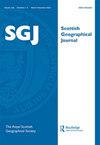冰川作用如何影响不列颠群岛动植物的进化历史和当代遗传多样性
IF 2
4区 社会学
Q2 GEOGRAPHY
引用次数: 0
摘要
本文章由计算机程序翻译,如有差异,请以英文原文为准。
How glaciation impacted evolutionary history and contemporary genetic diversity of flora and fauna in the British Isles
ABSTRACT Ice coverage not only affects the climate and landscape of geographical regions but has impacted species composition, the fragmentation and isolation of populations, and the colonisation routes of species post-glaciation. Major advancements in generating genetic data and applying sophisticated analyses to accurately model the demographic and colonisation history of animal and plant species has allowed evolutionary biologists novel insights. Meanwhile, physical geographers have made major advancements in reconstructing glacial history. However, the information flow between the geographic and evolutionary fields on this topic remains limited; consequently, evolutionary studies on contemporary biodiversity and species colonisation tend to be vague about the role of glacial history, while evolutionary and biodiversity information is rarely leveraged when discussing historical glaciation. In this review, we bring together current knowledge on the changing patterns of ice coverage in the British Isles from the maximum extent of the British-Irish ice sheet (BIIS) ca. 27 ka through to the end of large-scale ice coverage at the start of the Holocene period ca. 11.5 ka. We do so to then highlight how glaciation affected species composition during this time period and the subsequent colonisation of temperate flora and fauna and the patterns of genetic variation seen in them.
求助全文
通过发布文献求助,成功后即可免费获取论文全文。
去求助
来源期刊

Scottish Geographical Journal
GEOGRAPHY-
CiteScore
1.80
自引率
20.00%
发文量
19
期刊介绍:
The Scottish Geographical Journal is the learned publication of the Royal Scottish Geographical Society and is a continuation of the Scottish Geographical Magazine, first published in 1885. The Journal was relaunched in its present format in 1999. The Journal is international in outlook and publishes scholarly articles of original research from any branch of geography and on any part of the world, while at the same time maintaining a distinctive interest in and concern with issues relating to Scotland. “The Scottish Geographical Journal mixes physical and human geography in a way that no other international journal does. It deploys a long heritage of geography in Scotland to address the most pressing issues of today."
 求助内容:
求助内容: 应助结果提醒方式:
应助结果提醒方式:


